Every chapter available in the Samacheer Kalvi Class 11th Bio Botany Solutions subject is explained clearly in an easy way. Learn the depth concept by referring to the Samacheer Kalvi 11th Bio Botany Solutions Chapter 10 Secondary Growth Questions and Answers. Have a look at every topic and get the complete knowledge on the Bio Botany Solutions subject. You do not need to search for many materials for a better understanding of Bio Botany Solutions. Just refer to Tamilnadu State Board Solutions pdf and have a grip on the total subject.
Tamilnadu Samacheer Kalvi 11th Bio Botany Solutions Chapter 10 Secondary Growth
I believe that the best book is like a best friend to know the complete world by sitting in one place. When you have the best book you have many options to get great knowledge. Selecting the best book will lead to reaching your goal. Students who are looking for the best book to learn Bio Botany Solutions can use Samacheer Kalvi Class 11th Bio Botany Solutions Chapter 10 Secondary Growth Questions and Answers. Immediately start your learning with Samacheer Kalvi Class 11th Bio Botany Solutions Solutions Pdf.
Samacheer Kalvi 11th Bio Botany Secondary Growth Text Book Back Questions and Answers
Question 1.
Consider the following statements In spring season vascular cambium:
(i) is less active
(ii) produces a large number of xylary elements
(iii) forms vessels with wide cavities of these
(a) (i) is correct but (ii) and (iii) are not correct
(b) (i) is not correct but (ii) and (iii) are correct
(c) (i) and (ii) are correct but (iii) is not correct
(d) (i) and (ii) are not correct but (iii) is correct
Answer:
(b) (i) is not correct but (ii) and (iii) are correct
Question 2.
Usually, the monocotyledons do not increase their girth, because:
(a) They possess actively dividing cambium
(b) They do not possess actively dividing cambium
(c) Ceases activity of cambium
(d) All are correct
Answer:
(b) They do not possess actively dividing cambium
Question 3.
In the diagram of lenticel identify the parts marked as A,B,C,D.
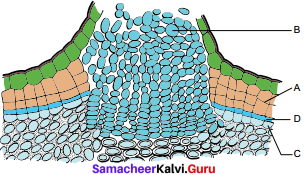
(a) A. Phellem, B. Complementary tissue, C. Phelloderm, D. Phellogen.
(b) A. Complementary tissue, B. Phellem, C. Phellogen, D. Phelloderm.
(c) A. Phellogen, B. Phellem, C. Pheiloderm, D. complementary tissue
(d) A. Phelloderm, B. Phellem, C. Complementary tissue, D. Phellogen
Answer:
(a) A. Phellem, B. Complementary tissue, C. Phelloderm, D. Phellogen.
Question 4.
The common bottle cork is a product of:
(a) Dermatogen
(b) Phellogen
(c) Xylem
(d) Vascular cambium
Answer:
(b) Phellogen
Question 5.
What is the fate of primary xylem in a dicot root showing extensive secondary growth?
(a) It is retained in the center of the axis
(b) It gets crushed
(c) May or may not get crushed
(d) It gets surrounded by primary phloem
Answer:
(b) It gets crushed
Question 6.
In a forest, if the bark of a tree is damaged by the horn of a deer, How will the plant overcome the damage?
Answer:
(Bark include all tissues outerto cambium)
- The innate wound healing mechanism get activated.
- In the wounded site, there is rapid cell division, in the cambium to seal the wound to prevent any microbial infection.
- A reaction zone is created, which alters the chemistry of the wood, in the wound site to avoid microbial infection.
- Barrier zone or callus sep; other, it over grow the wound and seal it, thereby new wood grow beneath to complete the healing.
Question 7.
In which season the vessels of angiosperms are larger in size, why?
Answer:
- Spring is a season with favourable climatic conditions, such as Optimum temperature, light intensity, good soil water source, which facilitate growth.
- So to optimize photosynthesis and in tum growth, cambium is very active, producing large number of xylary elements such as vessels and tracheids with wide lumen – (springwood) thus increases uptakeof water and minerals to large scale.
Question 8.
Continuous state of dividing tissue is called meristem. In connection to this, what is the role of lateral meristem?
Answer:
Apical meristems produce the primary plant body. In some plants, the lateral meristem increase the girth of a plant. This type of growth is secondary because the lateral meristem are not directly produced by apical meristems. Woody plants have two types of lateral meristems: a vascular cambium that produces xylem, phloem tissues and cork cambium that produces the bark of a tree.
Question 9.
A timber merchant bought 2 logs of wood from a forest & named them A & B, The log A was 50 year old & B was 20 years old. Which log of wood will last longer for the merchant? Why?
Answer:
Growth (or) Annual Rings:
1. In spring season cambium is very active and produces large number of xylary elements called Earlywood or Springwood.
In Winter season – cambium is less active and form few xylary elements – Latewood or Autumn Wood.
2. The springwood is lighter in colour and has a lower density whereas the autumn wood is darker and has a higher density. The annual ring denotes the combination of earlywood and latewood and the ring becomes evident to our eye due to the high density of latewood. Sometimes annual rings are called growth rings
3. Pseudo – Annual Rings :
Additional growth rings are developed within a year due to adverse natural calamities like drought, frost defoliation, flood, mechanical, injury and biotic factors. Such rings arc called pseudo – or false – annual rings
4. Dendrochronology:
Each annual ring corresponds to one year’s growth and on the basis of these rings, the age of a particular plant can easily be calculated. The determination of the age of a tree by counting the annual rings is called dendrochronology.
The wood of 50 years old will last longer than 20 years old wood, because timber from hard wood is more durable and more resistant to the attack of micro organisms and insect than the timber from sap wood.
Question 10.
A transverse section of the trunk of a tree shows concentric rings which are known as growth rings. How are these rings formed? What are the significance of these rings?
Answer:
The annual ring denotes the combination of early wood and late wood and the ring becomes evident to our eye due to the high density of late wood. Sometimes annual rings are called growth rings but it should be remembered all the growth rings are not annual. In some trees more than one growth ring is formed with in a year due to climatic changes. Additional growth rings are developed within a year due to adverse natural calamities like drought, frost, defoliation, flood, mechanical injury and biotic factors during the middle of a growing season, which results in the formation of more than one annual ring.
Such rings are called pseudo – or false – annual rings. Each annual ring corresponds to one year’s growth and on the basis of these rings, the age of a particular plant can easily be calculated. The determination of the age of a tree by counting the annual rings is called dendrochronology.
Samacheer Kalvi 11th Bio Botany Secondary Growth Other Important Questions & Answers
I. Choose the correct answer. (1 Mark)
Question 1.
Growth in Girth is also known as
a) Primary growth or longitudinal growth
b) Secondary growth or attitudinal growth
c) Secondary growth or vertical growth
d) Primary growth or latitudinal growth
Answer:
b. Secondary or attitudinal growth
Question 2.
The increase in the girth of the plant is called:
(a) primary growth
(b) tertiary growth
(c) longitudinal growth
(d) secondary growth
Answer:
(d) secondary growth
Question 3.
Secondary growth occur in
a) Grass
b) Paddy
c) Wheat
d) Yucca
Answer:
d. Yucca
Question 4.
Choose the correct statements.
(i) A strip of vascular cambium is present between xylem and phloem of the vascular bundle.
(ii) Vascular cambium is believed originate from fusiform initials.
(iii) The vascular cambium is originated from procambium of vascular bundle
(iv) Vascular cambium is present between fusiform initials and ray initials
(a) (i) and (iv)
(b) (i) and (iii)
(c) (ii) and (iii)
(d) (ii) and (iv)
Answer:
(b) (i) and (iii)
Question 5.
Match the following:
| A. Xylem | (i) Treachery elements |
| B. Secondary xylem | (ii) Water transport |
| C. Phloem | (iii) Sieve elements |
| D. Secondary phloem | (iv) Food transport |
(a) B – (i); A – (ii); C – (iii); D – (iv)
(b) B – (ii); A – (iii); C – (i); D – (iv)
(c) A – (ii); B – (i); C – (iv); D – (iii)
(d) A – (i); B – (ii); C – (iii); D – (iv)
Answer:
(c) A – (ii); B – (i); C – (iv); D – (iii)
Question 6.
Why do we consider cambium as a Lateral meristem?
a) Because it gives rise to lateral branches
b) Because it causes growth in girth
c) Because it increases the height and diameter of a plant
d) Because it adds bulk to a plant
Answer:
b. Because it causes growth in girth
Question 7.
The study of wood by preparing sections for microscopic observation is termed as:
(a) histology
(b) xylotomy
(c) phlebotomy
(d) anatomy
Answer:
(b) xylotomy
Question 8.
The amount of secondary xylem is more than secondary phloem because
a) Cambium is more active on the outer side
b) Cambium is more active on the inner side
c) Cambium has no role
d) Cambium is active equally on both sides but xylem is required more ti t m phloem
Answer:
b. Cambium is more active on the inner side
Question 9.
The axial system Consists of vertical files of:
(a) treachery elements and sieve elements
(b) treachery elements and apical parenchyma
(c) sieve elements are fibers
(d) treachery elements, fibers, and wood parenchyma
Answer:
(d) treachery elements, fibers, and wood parenchyma
Question 10.
Morus rubra has:
(a) porous wood
(b) softwood
(c) springwood
(d) sapwood
Answer:
(a) porous wood
Question 11.
Duramen is present in
a) Inner regions of secondary wood.
b) Part of sapwood
c) Outer region of secondary wood
d) Region of pericycle
Answer:
a) Inner region of secondary wood
Question 12.
Usually, more distinct annual rings are formed:
(a) in tropical plants
(b) in seashore plants
(c) in temperate plants
(d) in desert plants
Answer:
(c) in temperate plants
Question 13.
False annual rings are formed due to:
(a) rain
(b) adverse natural calamities
(c) severe cold
(d) none of the above
Answer:
(b) adverse natural calamities
Question 14.
When one wood is lighter in colour with a lower density, the other wood is darker with a higher density. They are
a) Springwood and autumn wood
b) Heartwood and latewood
c) Springwood and earlywood
d) Sapwood and springwood
Answer:
a) Springwood and Autumn wood
Question 15.
The age of the American Sequoiadendron tree is about:
(a) 350 years
(b) 3,000 years
(c) 3400 years
(d) 3500 years
Answer:
(d) 3500 years
Question 16.
The wood of Acer plant has:
(a) ring porous
(b) diffuse-porous
(c) central porous
(d) none of the above
Answer:
(b) diffuse-porous
Question 17.
A vessel less piece of stem possessing prominent sieve tubes would belong to
a) Pinus
b) Eucalyptus
c) Grass
d) Trochodendron
Answer:
d. Trochodendron
Question 18.
In bombax:
(a) the sieve tubes are blocked by tylose like outgrowths
(b) the resin ducts are blocked by tylose like outgrowths
(c) the phloem tube is blocked by tylose like outgrowths
(d) none of the above
Answer:
(a) the sieve tubes are blocked by tylose like outgrowths
Question 19.
The meristem responsible for extra stelar secondary growth in shoot stem is
a) Fascicular cambium
b) Interfascicular cambium
c) Intercalary meristem
d) Cork cambium
Answer:
d. Cork cambium
Question 20.
Timber from heartwood is:
(a) more fragile and resistant to the attack of insects
(b) more durable and more resistant to the attack of microorganism and insects
(c) harder and less resistant to the attack of microorganism
(d) less durable and more resistant to the attack of microorganism and insects
Answer:
(b) more durable and more resistant to the attack of microorganism and insects
Question 21.
The dye, hematoxylin is obtained from:
(a) the heartwood of Haematoxylum campechianum
(b) the sapwood of Haematoxylum campechianum
(c) cambium cells of Haematoxylum campechianum
(d) the seeds of Haematoxylum campechianum
Answer:
(a) the heartwood of Haematoxylum campechianum
Question 22.
Which one of the tissue is formed in a stem from cells cut off by the cambium on its inner side?
a) Wood fibres
b) bast fibres
c) Sieve tubes
d) Campanian cells
Answer:
a. Wood fibers
Question 23.
Some commercially important phloem or bast fibres are obtained from:
(a) banana
(b) bamboo
(c) vinca rosea
(d) cannabis sativa
Answer:
(d) cannabis Sativa
Question 24.
Phellogen comprises:
(a) homogeneous sclerenchyma cells
(b)homogeneous meristematic cells
(c) homogeneous collenchyma cells
(d) none of the above cells
Answer:
(b)homogeneous meristematic cells
Question 25.
How many shoot apical meristems are likely to be present in a twig of a plant possessing 4 branches and 26 leaves
a) 26
b) 1
c) 5
d) 30
Answer:
c) 5
Question 26.
Lenticel is helpful in:
(a) transportation of food
(b) photosynthesis
(c) exchanges of gases and transpiration
(d) transportation of water
Answer:
(c) exchanges of gases and transpiration
Question 27.
External protective tissues of dicot stem are
a) Cork and pericycle
b) Cortex and epidemic
c) Pericycle and cortex
d) Epidermis and cork
Answer:
d) Epidermis and Cork
Question 28.
Gum Arabic is obtained from:
(a) Hevea brasiliensis
(b) Acacia Senegal
(c) Pinus
(d) Dilonix regia
Answer:
(b) Acacia Senegal
Question 29.
Turpentine used as thinner of paints is obtained from:
(a) Acacia Senegal
(b) Vinca rosea
(c) Hevea brasiliensis
(d) Pinus
Answer:
(d) Pinus
Question 30.
The wood formed early occur during
a) Autumn season
b) Spring season
c) Winter season
d) Summer season
Answer:
b) Spring season
II. Answer the following. (2 Marks)
Question 1.
Define primary growth?
Answer:
The roots and stems grow in length with the help of apical meristems. This is called primary growth or longitudinal growth.
Question 2.
Name the tissues that bring out secondary growth in dicots.
Answer:
- It is the lateral Meristem – that brings out secondary growth.
- It is divided into Vascular cambium, Cork cambium
- Vascular cambium gives rise to secondary xylem and secondary phloem
- The cork cambium gives rise to the secondary cortex. and phellem.
Question 3.
What is meant by vascular cambium?
Answer:
The vascular cambium is the lateral meristem that produces the secondary vascular tissues. i.e., secondary xylem and secondary phloem.
Question 4.
Define intrafascicular or fascicular cambium?
Answer:
A strip of vascular cambium that is believed to originate from the procambium is present between the xylem and phloem of the vascular bundle. This cambial strip is known as intrafascicular or fascicular cambium.
Question 5.
Differentiate between Cork and Rubber
Answer:
Cork:
- It is a part of the bark
- It is non-living tissue
- Used in making bottle stoppers
- Eg. Querces suber
Rubber:
- It is derived as stem latex
- It is a secondary metabolite
- 80-85% of the world’s Rubber products like tyre are produced from this plant
- Eg. Hevea brasiliensis
Question 6.
What is vascular cambial ring?
Answer:
This interfascicular cambium joins with the intrafascicular cambium on both sides to form a continuous ring. It is called a vascular cambial ring.
Question 7.
What is meant by stratified cambium?
Answer:
If the fusiform initials are arranged in horizontal tiers, with the end of the cells of one tier appearing at approximately the same level, as seen in Tangential Longitudinal Section (TLS), it is called storied (stratified) cambium.
Question 8.
Explain non – stratified cambium.
Answer:
In plants with long fusiform initials, they strongly overlap at the ends, and this type of cambium is called non – storied (non – stratified) cambium.
Question 9.
Give a brief note on ray initials.
Answer:
These are horizontally elongated cells. They give rise to the ray cells and form the elements of the radial system of secondary xylem and phloem.
Question 10.
How does secondary xylem or wood form?
Answer:
The secondary xylem, also called wood, is formed by a relatively complex meristem, the vascular cambium, consisting of vertically (axial) elongated fusiform initials and horizontally (radially) elongated ray initials.
Question 11.
What is meant by spring wood?
Answer:
In the spring season, cambium is very active and produces a large number of xylary elements having vessels/tracheids with a wide lumen. The wood formed during this season is called springwood or earlywood.
Question 12.
How does the autumn wood form?
Answer:
In winter, the cambium is less active and forms fewer xylary elements that have narrow vessels/tracheids and this wood is called autumn wood or latewood.
Question 13.
Define growth rings?
Answer:
The annual ring denotes the combination of earlywood and latewood and the ring becomes evident to our eye due to the high density of latewood. Sometimes annual rings are called growth rings.
Question 14.
Define dendroclimatology?
Answer:
It is a branch of dendrochronology concerned with constructing records of past climates and climatic events by analysis of tree growth characteristics, especially growth rings.
Question 15.
Explain diffuse-porous woods with an example.
Answer:
Diffuse porous woods are woods in which the vessels or pores are rather uniform in size and distribution throughout an annual ring. eg: Acer
Question 16.
What is meant by ring-porous woods?
Answer:
The pores of the earlywood are distinctly larger than those of the latewood. Thus rings of wide and narrow vessels occur.
Question 17.
Define tyloses?
Answer:
In many dicot plants, the lumen of the xylem vessels is blocked by many balloon like ingrowths from the neighbouring parenchymatous cells. These balloons like structures are called tyloses.
Question 18.
Mention two plants from which bast fibres are obtained.
Answer:
Two plants from which bast fibres are obtained:
- Flax – Linum ustitaissimum
- Hemp – Cannabis sativa
Question 19.
What is Amber? What is its use?
Answer:
- Amber is a fossilized tree resin got from wood.
- It is appreciated for its colour and natural beauty since Neolithic times.
- Value as a gemstone – variety of decorative objects made out of it.
- Used in jewellery making.
- Used as a healing agent in folk medicine.
Question 20.
What is polyderm? Explain briefly.
Answer:
Polyderm is found in the roots and underground stems. eg: Rosaceae. It refers to a special type of protective tissues consisting of uniseriate suberized layer alternating with multiseriate nonsuberized cells in periderm.
Question 21.
Define’bark’?
Answer:
The term ‘bark’ is commonly applied to all the tissues outside the vascular cambium of stem (i.e., periderm, cortex, primary phloem and secondary phloem).
Question 22.
What are the functions of lenticel?
Answer:
Lenticel is helpful in exchange of gases and transpiration called lenticular transpiration.
Question 23.
Explain briefly phelloderm.
Answer:
It is a tissue resembling cortical living parenchyma produced centripetally (inward) from the phellogen as a part of the periderm of stems and roots in seed plants.
Question 24.
What is the function of secondary phloem?
Answer:
Secondary phloem is a living tissue that transports soluble organic compounds made during photosynthesis to various parts of plant.
Question 25.
what is periderm?
Answer:
Whenever stems and roots increase in thickness by secondary growth, the periderm, a protective tissue of secondary origin replaces the epidermis and Often primary cortex. The periderm consists of phellem, phellogen, and phelloderm.
III. Answer the following. (3 Marks)
Question 1.
Define the following:
Answer:
A-Phelloids, B – Xylotomy, C – Tylosoids
Phelloids: Phellem (cork) like cells, which lack suberin in their walls are known as phelloids.
Xylotomy: The study of wood by preparing sections for microscopic observation is known as xylotomy.
Tylosoids: These are tylose-like in growth from neighbouring parenchyma cells blocking the lumen of the parts, such as Resinduct – sieve tubes etc.
Eg. Resin ducts – Eg. Pinus (Gymnosperm), Sieve tube – Eg. Boombox (Angiosperm)
Question 2.
Explain fusiform initials.
Answer:
These are vertically elongated cells. They give rise to the longitudinal or axial system of the secondary xylem (treachery elements, fibers, and axial parenchyma) and phloem (sieve elements, fibers, and axial parenchyma).
Question 3.
Distinguish between Ring barks and scale barks
Answer:
Ring barks:
- When Phellogen form a complete cylinder around the stem, it is ringbark
- It won’t peel off
- Eg. Quercus
Scale barks:
- The bark is formed by overlapping scale-like layers
- It often peels off
- Eg. Guava
Question 4.
Write down the differences between spring wood and autumn wood.
Answer:
The differences between springwood and autumn wood:
| Spring wood or Earlywood |
Autumn wood or Late wood |
| 1. The activity of the cambium is faster. | 1. Activity of cambium is slower. |
| 2. Produces a large number of xylem elements. | 2. Produces fewer xylem elements. |
| 3. Xylem vessels / trachieds have wider lumen. | 3. Xylem vessels / trachieds have narrow lumen. |
| 4. Wood is lighter in colour and has lower density. | 4. Wood is darker in colour and has a higher density. |
Question 5.
How do you distinguish between sapwood and heartwood?
Answer:
| Sap wood (Alburnum) |
Heartwood (Duramen) |
| 1. Living part of the wood. | 1. Dead part of the wood. |
| 2. It is situated on the outer side of wood. | 2.It is situated in the certre part of wood. |
| 3. It is less in coloured. | 3. It is dark in coloured. |
| 4. Very soft in nature. | 4. Hard in nature. |
| Tyloses are absent. | Tyloses are present. |
| 5. It is not durable and not resistant to microorganisms. | 5. It is more durable and resists microorganisms. |
Question 6.
What are fossil resins? Explain with an example.
Answer:
Plants secrete resins for their protective benefits. Amber is a fossilized tree resin especially from the wood, which has been appreciated for its colour and natural beauty since neolithic times. Much valued from antiquity to the present as a gemstone, amber is made into a variety of decorative objects. Amber is used in jewellery. It has also been used as a healing agent in folk medicine.
Question 7.
Write briefly about Cork cambium.
Answer:
It is a secondary lateral meristem. It comprises homogenous meristematic cells unlike vascular cambium. It arises from epidermis, cortex, phloem or pericycle (extrastelar in origin). Its cells divide periclinally and produce radially arranged files of cells. The cells towards the outer side differentiate into phellem (cork) and those towards the inside as phelloderm (secondary cortex).
Question 8.
Differences between Vascular Cambium and Cork cambium
Answer:
Vascular cambium
- Also called Cambium
- In standardises from Pro cambium & Interfascicular parenchyma
In roots – arises from conjunctive parenchyma - It comprises long fusiform and short and initials.
- It produces secondary phloem towards the outer side the secondary xylem towards the inner side
Cork cambium :
- Also called Phellogen
- In stem – arises from epidermis, cortex & phloem
In roots – arises from pericycle - It comprises homogenous cells.
- It produces phellem (cork) towards the outer side and phelloderm (secondary cortex) towards the inner side.
Question 9.
Differentiate between Dicot stem and Dicot root with reference to secondary growth meristems.
Answer:
Dicot stem:
- Vascular cambium, partially primary and partially secondary in origin
- Phellogen formed from outer Cortical cells
- Vascular cambium formed from interstellar cells and phellogen from extra stellar cells
Dicot root:
- Vascular cambium is purely secondary in origin
- Phellogen formed from Pericycle
- Both vascular cambium and phellogen from Intra stelar cells
Question 10.
Distinguish between Intrafascicular Interfascicular cambium.
Answer:
Between Intrafascicular Interfascicular cambium:
| Intrafascicular cambium |
Interfascicular cambium |
| 1. Present inside the vascular bundles | 1. Present in between the vascular bundles. |
| 2. Originates from the procambium. | 2. Originates from the medullary rays. |
| 3. Initially it forms a part of the primary meristem. | 3. From the beginning it forms a part of the secondary meristem. |
IV. Answer In detail
Question 1.
Describe the activity of vascular with the help of diagram.
Answer:
The activity of Vascular Cambium:
The vascular cambial ring, when active, cuts off new cells both towards the inner and outer side. The cells which are produced outward form secondary phloem and inward secondary xylem. At places, cambium forms some narrow horizontal bands of parenchyma which passes through secondary phloem and xylem. These are the rays. Due to the continued formation of secondary xylem and phloem through vascular cambial activity, both the primary xylem and phloem get gradually crushed.
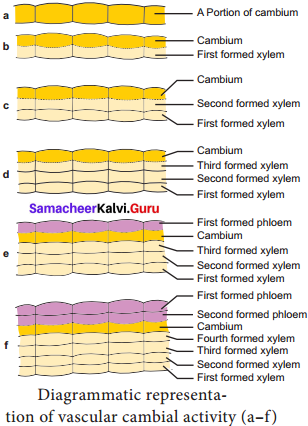
Question 2.
Describe the formation of sap wood and heartwood with suitabie diagram.
Answer:
Sap wood and heart wood can be distinguished in the secondary xylem. In any tree the outer part of the wood, which is paler in colour, is called sap wood are alburnum. The centre part of the wood, which is darker in colour is called heart wood or duramen. The sap wood conducts water while the heart wood stops conducting water. As vessels of the heart wood are blocked by tyloses, water is not conducted through them.
Due to the presence of tyloses and their contents the heart wood becomes coloured, dead and the hardest part of the wood. From the economic point of view, generally the heartwood is more useful than the sapwood. The timber form the heartwood is more durable and more resistant to the attack of microorganisms and insects than the timber from sapwood.
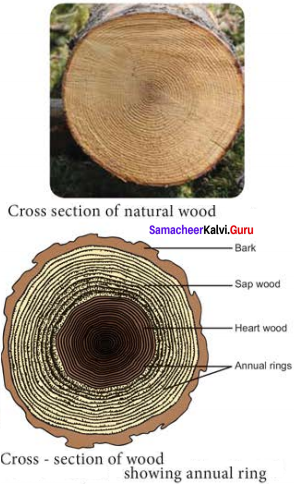
Question 3.
Draw and label the transverse section of dicot stem showing the secondary growth.
Answer:
The transverse section of dicot stem showing the secondary growth:
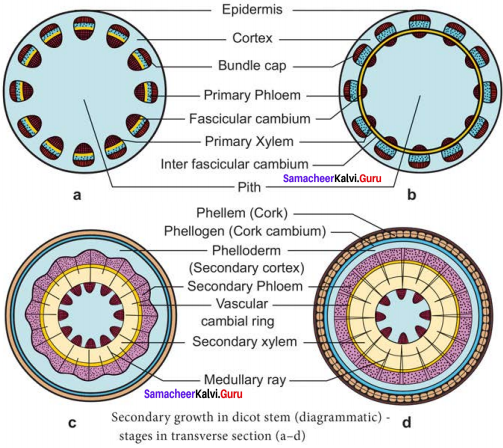
Question 4.
Differentiate between Secondary xylem and Secondary phloem
Answer:
Secondary xylem:
- It is known as wood –
- It is formed towards the inside of the vascular cambium
- From Fusiform initials, the axial system is developed consists of tracheary elements, fibres and parenchyma
From ray initials, the radial system consists of rows of parenchyma cells - Wood is of 2 types porous wood (Hard) & Non-Porous wood
- Varies – vary greatly from species to species
- Life span – long
- It is dead – conduction does not occur
- Commercially important
Secondary phloem
- It is formed towards the outside of vascular cambium
- From fusiform initials, axial system is developed consists of sieve elements phloem fibres and phloem parenchyma
From ray initials, the radial system consists of phloem rays. - no much variation
- Life span comparatively shorter than sec. xylem
- It is living tissue, help in transport of organic solutes from leaves to other parts
- Commercially bast fibres are used
Question 5.
Write down the economic importance of tree bark.
Answer:
The economic importance of tree bark:
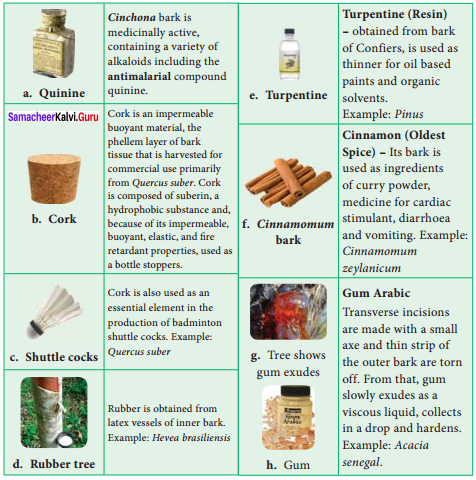
Question 5.
Draw the different stages of secondary growth in a dicot root and label the parts.
Answer:
Stages of secondary growth in a dicot root and label the parts:
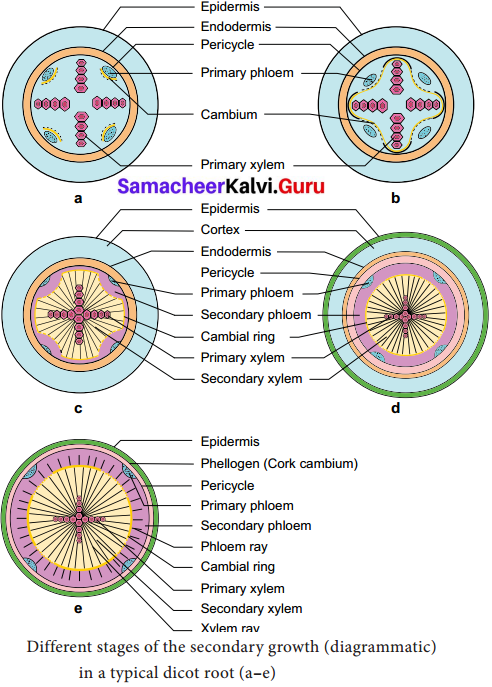
Solution To Activity
Textbook Page No: 38
Question 1.
Generally monocots do not have secondary growth, but palms and bamboos have woody stems. Find the reason.
Answer:
Some of the monocots like palm and bamboos show an increase in thickness of stems by means of secondary growth or latitudinal growth.
Textbook Page No: 48
Question 2.
Be friendly with your environment (Eco friendly) Why should not we use the natural products which are made by plant fibres like rope, fancy bags, mobile pouch, mat and gunny bags etc., instead of using plastics or nylon?
Answer:
We should not use the natural products, which are made by plants fibres, because, if we use more of plant products the greedy people will exploit the plant resources for making plant products and thereby depleting the tree cover, which in turn causes reduction in rain fall.
Hope all the information given regarding Class 11th Tamilnadu State Board Bio Botany Solutions will help you to get good knowledge. For any queries, you can contact us and clear your doubts. Connect with us using the comment section. Also, we love your feedback and review. Get your Chapter Wise Samacheer Kalvi Class 11th Textbook Solutions for Bio Botany Solutions Chapter 10 Secondary Growth Questions and Answers PDF start learning for the exam.